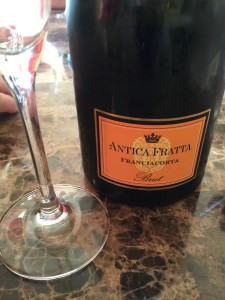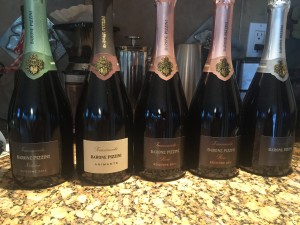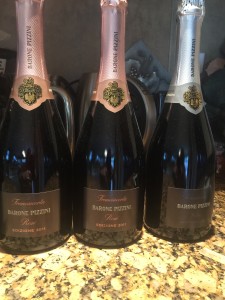Franciacorta is my new favorite sparkling wine, but I guarantee most wine lovers don’t have it in their wine cellar, have gone in search of it or even know about it. Here is the story of those tiny bubbles and how I came to love them.
Several years ago some of our wine loving friends decided to host a northern Italian food and wine paired event. Most of us in this small group of wine aficionados really enjoy tasting wine varietals new to us, so my personal mission was to do the research and contribute a lesser known northern Italian wine or two and the food that Italians enjoy with the wine. I love a good food and wine challenge!
We have attended numerous wine classes through the years and tasted a lot of wine and are definitely familiar with Amarone, Barolo and Barbaresco just to name a few. We have even enjoyed a few Pinot Grigios from Italy. We have also acquired a taste for sparkling wine while tasting through the specialties of every wine-making country. One of our wine instructors, Jerry Greenfield, author of “The Wine Whisperer”, taught us to taste a lot of wine in order to learn about it, and we hated to disappoint him! We especially enjoy Champagne but often drink sparkling wine from other French regions or other countries. That leads me to Prosecco, an enjoyable Italian sparkling wine from norther Italy that is actually made from the Glera grape varietal, so that in itself should qualify as a lesser known varietal. Our taste in Prosecco and most wines tends to the very dry side, so while Prosecco is usually value –priced, we always check the label to be sure it is Brut before we buy or order. Prosecco is made with its second fermentation in a stainless steel tank, which is called the charmat method of making sparkling wine, while a traditional Champagne undergoes secondary fermentation in the bottle. That is where those tiny bubbles come from. The alternate process means that Prosecco can be far less expensive than traditional Champagne.
Enter Franciacorta (frahn-chah-COR-tah)…….. While I was doing my northern Italian wine search thanks to Google, I came across a wine very new to me. I couldn’t even pronounce it, not that I can speak any Italian! When I read that Franciacorta is actually made in the traditional Champagne method and only exists in a very small area, I knew I had found the perfect “unknown” wine. I ordered two bottles, presented them at our dinner, then proceeded to forget all about it because there wasn’t any of it on the shelves of our local wine merchants in those days especially with the closing of our beloved Austin’s Wine Cellar.
While I was doing my northern Italian wine search thanks to Google, I came across a wine very new to me. I couldn’t even pronounce it, not that I can speak any Italian! When I read that Franciacorta is actually made in the traditional Champagne method and only exists in a very small area, I knew I had found the perfect “unknown” wine. I ordered two bottles, presented them at our dinner, then proceeded to forget all about it because there wasn’t any of it on the shelves of our local wine merchants in those days especially with the closing of our beloved Austin’s Wine Cellar.
Franciacorta is located in Lombardy less than an hour away from Milan in the province of Brescia. DOCG status is exclusively for grapes grown in the territory of Franciacorta and it has nothing to do with France even though the name sounds like it! There are only 2800 hectares (5700 acres) compared to over 34,000 hectares in Champagne, so Champagne need not worry about being overtaken by Franciacorta. The wines from this area date back to the 1200s but were not called Franciacorta until 1957 when Guido Berlucchi made a white wine that he called Pinot di Franciacorta. There were 11 producers of sparkling Franciacorta by the time they were granted DOC status in 1967. In 1995 they were given DOCG status. The wine must be made by “metodo classico” just as Champagne is made by “mέthode Champenoise”. Grape varietals used must be Chardonnay, Pinot Noir and Pinot Blanco. Only a small percentage is exported; guess the Italians like to keep a good thing for themselves! The most popular style of Franciacorta is Brut (which means I will like it!) with floral scents and fruity notes of white-fleshed pears, hazelnuts and yeast. It comes in vintage and non-vintage. They also make rosé, my personal sparkling favorite. The climate here is sub-Alpine with milder winters than in the Alps, hot and dry summers and rainy autumns. The soil is primarily a red mixture of clay and silt.
Those of you, who know us well, know that Chuck and I enjoy attending wine dinners in the Fort Myers-Cape Coral- Lee County area. We have been regular wine dinner attendees at Angelina’s Ristorante in Bonita Springs for many years. We often get to enjoy wines that are new to us, varietals that may be unfamiliar to us, and to meet the winemaker who actually made the wine all without taking an expensive trip to wine country. They are very special experiences for us. If you are also interested in getting to taste different wines that are paired with food creatively inspired by the restaurant chef, wine dinners are a great alternative to explore. It is time to shine for both the chef and the wine!
Last September we had the opportunity to attend an Angelina’s special dinner paired with the sparkling wines made by the Franciacorta Barone Pizzini winery.
Silvano Brescianini, general manager and founding partner of Barone Pizzini, poured our wines and told us about the details that made each one so special. Barone Pizzini, founded in 1870, is one of the oldest wineries in Franciacorta and has been a pioneer for organic sustainable farming. In 1998 the winery started experimenting with organic grape growing and in 2001 applied for organic certification. In 2007 they opened a new bioarchitecture winery with two-thirds of the building being underground and have since won awards for sustainable viticulture. The estate currently has 25 vineyards covering 47 hectares. The average age of their vines is 15 years.
I fell in love with these wines and am happy to say that after much research and special ordering, four varieties of their wines now reside in our cellar!
Tasting notes:
Animante Brut Franciacorta DOCG – straw yellow in color with notes of flowers, citrus, acacia honey, apricot and dried fruit – 78% Chardonnay, 18% Pinot Noir, 4% Pinot Blanco – 90 pt WA
Nature Franciacorta DOCG Brut Edizione 2011 – part of the grapes come from a higher elevation with limestone-rich soil which gives the wine a mineral note.
Rosέ Franciacorta DOCG Brut Edizione 2011 – a Franciacorta rosé must contain at least 15% Pinot Noir; has notes of underbrush, currant, blueberry and hints of rose petal in the glass.
Satέn Franciacorta DOCG Edizione 2011 – 100% Chardonnay with a silky smooth character, citrus notes and minerality. A Franciacorta Satέn (yes, it should resemble satin!) must be a Blanc de Blanc with only Chardonnay or Pinot Blanc permitted. 5532 cases of this vintage were made – 91 pt WA
Hopefully you will now be on the lookout for Franciacorta and feel on the cutting edge when you place your order and can tell your wine friends all about it. Papillon Champagne and Wine Bar, located in Cape Coral, was offering Antica Fratta Franciacorta earlier this year; however the wine line-up in wine bars and restaurants do change, so don’t be surprised if everyone else beat you to it! A wine shop in Naples was kind enough to order the Barone Pizzini wines for us, but I am not sure of their current inventory. Several Italian restaurants in the area may be offering them on their wine list.
Today there are over one hundred wineries in Franciacorta with a sparkling wine production of over 15 million bottles a year. Several other makers of Franciacorta to search out are Bellavista, Berluchi and Ca’ del Bosco all of which are rated in the April 30, 2016 issue of Wine Spectator magazine.
Hope you have enjoyed reading about my new favorite sparkling wine and why those tiny bubbles are so special to me, have gained some new wine information, and that you may even go out in search for your own. Better yet – let’s all enjoy it together! Salute!!!!



